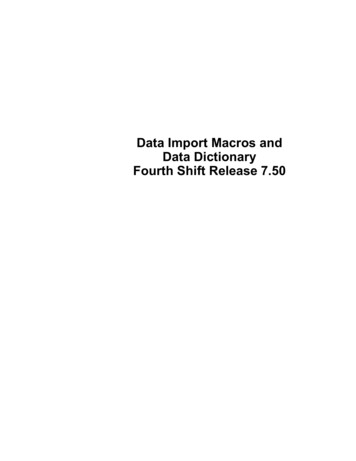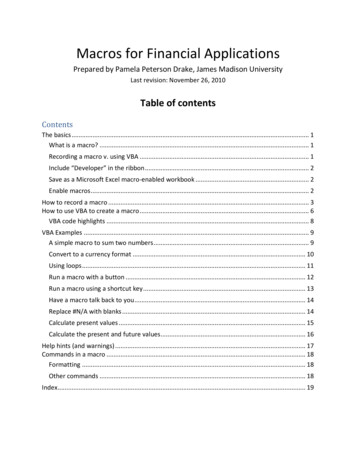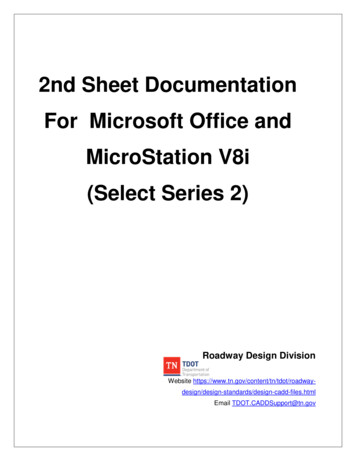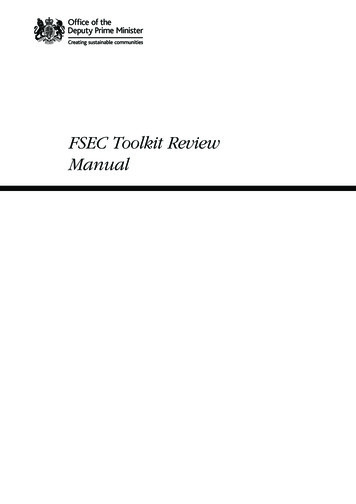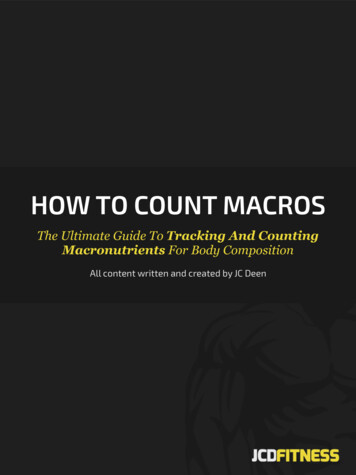
Transcription
HOW TO COUNT MACROSThe Ultimate Guide To Tracking And CountingMacronutrients For Body CompositionAll content written and created by JC Deen
Hey — I bet you’ll nod in agreement with me whenI say that counting your macros can be confusingand hard to figure out.It can even seem annoying and obnoxious, but isit really that hard?Here’s the thing: counting macros is pretty easywhen you know how to do it properly. And it canbe one of the best skills you develop when it comes to building yourdream body.In this guide on how to count macros, I’m going to show you every singlething you need to know about counting and tracking your intake.You’ll walk away from this guide knowing exactly what to do and how todo it, even if the thought of counting sounds miserable and boring.And if you have questions, feel free to get in touch with me.
HERE'S WHY LEARNING HOW TO COUNTMACROS WILL MAKE YOUR FAT LOSSAND MUSCLE GAIN EFFORTS EASIERIf there was one thing I could teach you, outside of how to train properly,it would be how to accurately track your caloric intake via countingmacronutrients.The reason for this is because out of all the things you could be doing,this one pays off the most in the end because it gives you so muchcontrol over your intake, and thusly your health and fitness goals.Here are a few reasons why this process pays off big time:You can accurately manage your caloric intake over time tohelp you lose fat, gain muscle, and improve your overallaesthetics.Once you learn how to count macros and get a sense of whata serving of protein, carbs, and fat look like, you will have abetter idea of how to estimate your intake when eating out.It’s a skill that will pay off in the long run because you took thetime to figure it out now, instead of leaving your macronutrientintake, and overall caloric intake, up to chance, which is ahorrible way to attempt to achieve any goal.FIRST OF ALL, WHAT AREMACRONUTRIENTS?
Macronutrients are what makes up the food we eat. They’re known as:ProteinCarbohydratesFatMacronutrients make up the total calories in our food and are required inlarge amounts to support life, activity, and cellular processes.Micronutrients are known as vitamins and minerals, which are required inmuch smaller amounts by the human body.Alcohol is technically not a macronutrient because it has zero nutritionalvalue (no vitamins or minerals) but it still contains calories and should betracked if you decide to consume it.Each macronutrient contains a certain amount of calories per gram, sowhile we’re focusing on counting macros, it serves as a purpose ofcontrolling and tracking calories.1 gram of protein 4 calories1 gram of carbohydrate 4 calories1 gram of fat 9 calories1 gram of alcohol 7 caloriesLet’s get into each macronutrient and their importance.
ProteinThis macro is what we all think of when it comesto building muscle, but it’s also equallyimportant for maintaining muscle mass on a fatloss diet.Protein is responsible for many functions in thebody, but for this guide, we’ll focus mostly onhow it helps us repair muscle tissue that’s beenbroken down from hard resistance training.When your body undergoes muscle repair, turnover, and thus, growth,this is a physiological process called anabolism, which is why proteincan be considered anabolic.What’s The Ideal Amount To Consume?The research suggests a range of .8g - 1.5g per pound of body weight.However, depending on your preferences for protein intake, trying toconsume 1.5g per pound can be quite the challenging (and sometimesexpensive) task. It can also make it harder to get other macros that areequally as important as protein.For most people, the recommendation of 1 gram per pound of body weight islikely ideal for positively changing your body composition. If you’re veryoverweight (with more than 50 pounds to lose), then multiplying your bodyweight by .7 - .8 is a great way to calculate your intake. Read more about thescience of how much protein you need per day.While protein is important for muscle gain, maintenance, and repair,eating above and beyond the above recommendations for daily intakewill not magically make your muscles grow faster nor will it aid in fasterfat loss. More is not always better when it comes to protein.
Quality Protein Sources:Lean chicken, beef, lamb, turkey, porkFresh fish, canned fishDeli meat (turkey and ham)Beef broth (gelatin)Tendon meat (from the connective tissue of beef, chicken,lamb, pork)Dairy (milk, cheese, yogurt)EggsIf you need some more protein-heavy food ideas for your intake, readhow to eat more protein.CarbohydrateThis macro is absolutely necessary for health,performance, and improved body composition.While it may be a hot debate about how manycarbohydrates are necessary among low-carbzealots, we know a few things for certain. Thebrain uses up to 20% of our daily expenditure,and it runs on glucose, which is the simplestform of sugar broken down in the body[2].To get technical, the body can survive on zero carbohydrates, but this isnot ideal. In this case, the body will break down the protein you’ve eaten,as well as your muscles, to use as glucose.Carbohydrates are stored in your liver and in your muscles. The storedcarbohydrates are known as glycogen, and this is the primary fuelsource for your high-intensity activities (hello weight training and sprints).
What’s The Ideal Amount To Consume?There is no ideal amount for every single person, but I like to see aminimum of 1 gram per pound of body weight at all times. And somepeople have been known to consume upwards of 500 grams per daywhen being active and training regularly.This is largely dependent on your body size, activity levels, and yourprimary form of exercise.A good range to think about is somewhere between 1 and 3 multiplied yourbody weight depending on the goal (fat loss, muscle gain, maintenance) andactivity levels. Carbohydrates are also a precursor to thyroid hormoneproduction, so a diet too low in carbohydrates can spell disaster for thyroidand metabolic health.Obviously someone with a high activity level will require more energythan someone who sits all day, so this is the reason for such wide rangeof carbohydrates.Quality Carbohydrate Sources:Potatoes (all varieties)Rice (brown and white)PastaFruitFresh fruit juice (no concentrates)All vegetablesBreadGrainsRead Don’t Fall For The Low-Carb Trap to learn more about why lowcarb diets aren’t the best solution for most people.
Popular question: “Should fiber be counted toward or subtracted frommacro totals?”Since fiber is not fully digested, some believe you shouldn’t account forit, but for ease of tracking, always account for it when tracking becauseyour intake can vary from day to day and it’s probably not worth worryingabout in the end.FatThis macro is an essential nutrient we all need,and it helps with the absorption of the fatsoluble vitamins (D, K, E, A). Fat is also anenergy source, right behind carbohydrates. Weburn fat when we’re at rest. It’s the backup fuelsource and is easily stored in the body as fat.And this makes sense based on how wesurvived throughout periods of feast andfamine.Fat also helps with hormone production (testosterone for men,progesterone for women), so a diet too low in fat could be detrimental toyour hormonal health.What’s The Ideal Amount To Consume?It will depend on the individual and their needs, but someone with ahigher energy expenditure from more activity will be able to eat more fatdue to the demands on their body from an energy balance perspective.In terms of a range, anywhere from 15-25% of your overall caloric intake isprobably ideal. This allows for enough fat in the diet to cover vitamin absorptionand hormone production needs, as well as makes your food taste good.
It’s often a misconception that eating a lot of fat will make you fat. Buteating lots of fat (or sugar) will not make you fat if you’re maintaining acaloric balance, or in a deficit. I explain more in this article: Is Sugar BadFor You And Does It Make You Fat?Quality Fat Sources:Coconut oilPalm oilOlive oilFats (beef, lamb) from grass fed animalsAvocadoEgg yolksDark chocolateTo get a full nutritional education on protein, carbohydrate, and fat, Ihighly recommend picking up a copy of The First Diet by Sean Bissell.You can read my review here.AlcoholThis macro is a non-nutrient and is not neededby the human body unless you’re just trying torelax or need some liquid courage to talk to thatstranger at the bar you fancy.*In fairly moderate amounts, it is toxic andpeople die of it every single day. Rememberthat alcohol does contain calories, and for everygram of alcohol, there are 7 calories.Here’s a quick guide on a number of calories in your favorite beverages(source):
Any hard liquor (1 shot) diet soda (1 ounce serving 80calories)Wine (5 ounces serving 120 calories)Cider / Beer (12 ounce serving 180-200 calories)*but even then, it’s not needed.THIS IS EXACTLY WHY MACROSMATTER (& HOW MANAGINGCALORIES IMPACTS YOUR RESULTS)Macros make up calories.Calories are the sole driver of weight gain and weight loss. Losing bodyweight is only possible in a caloric deficit and gaining weight onlypossible in a surplus.It also matters because we (humans) are notoriously bad at estimatingour intake. One study states “The failure of some obese subjects to loseweight while eating a diet they report as low in calories is due to anenergy intake substantially higher than reported and an overestimationof physical activity, not to an abnormality in thermogenesis.”[1]
So while you might think you’re eating very little food, but still not losingweight, you could actually be eating a lot more without realizing it.As a result, counting macros for a period of time can help you betterunderstand how much you’re actually consuming versus what you thinkyou’re consuming.Every macronutrient contains calories. And since calories are the energyour bodies use on a daily basis, the total amount of macronutrients youconsume dictates your overall calorie intake.Changing your body composition is all about managing energy balance,which simply means the following:If you want to gain weight you must consume more energythan you burn.If you want to lose weight, you must consume less energythan you burn.If you want to maintain your weight and body composition,you must consume enough energy to meet the demands ofyour activity levels.Here’s how your macronutrient split makes up the total calories in yourdiet.Let’s say you weigh 150 pounds and you’re wanting to maintain yourweight. You train at the gym 4 days per week and you work a job thathas you at a desk most of the day. But outside of work, you’re fairlyactive walking and keeping busy.For hypothetical purposes, here’s the scenario.Remember the following values for calories per gram of eachmacronutrient:— 1 gram of protein 4 calories— 1 gram of carbohydrate 4 calories— 1 gram of fat 9 calories
Let’ assume that at 150 pounds, it takes about 2300 calories to maintainyour body weight.Using the figures from above, we’ll determine your macronutrient split asthe following:150g of protein // 1 x 150 (1 multiplied by your body weight)50g of fat // 20% x 2300 (20% of total calorie intake)SIMPLE MATH150g x 4 600 calories50g x 9 450 calories600 450 1050Now we have to figure out the carbohydrate intake. We already know themaintenance calorie figure, so we simply subtract that from the proteinand fat calories.Total maintenance calories: 23002300 - 1050 1250 calories left for the carbohydrate total.1250 / 4 312.5g So our total macronutrient intake would be:150 grams of protein50 grams of fat312 grams of carbohydrateThis macronutrient split makes up the total of 2300 calories.
READING A NUTRITIONLABEL (MADE EASY)Nutrition labels are easy to read once you know how. So let’s learn realquickly.Here is a label from Daisy brand 2%cottage cheese. From top to bottom,you have the all the pertinent info asfollows:Serving sizeCaloriesTotal fatTotal carbohydrateTotal Protein% Daily valueWhen we’re counting macros, thetotal calories aren’t relevantbecause, in the end, yourmacronutrient split is always in linewith the calorie recommendations.In this example, there are 2.5 gramsof fat, 4 grams of carbohydrate and13 grams of protein.
DO THE MATH2.5 (grams of fat) x 9 22.5 calories4 (grams of carbohydrate) x 4 16 calories13 (grams of protein) x 4 5252 16 22.5 90.5 calories.NOTE: sometimes labels will be 5-10 calories above or below the totalcalories on the package. The reason for this is because companies tendto round up or down to an even number for sake of tracking. This is whyyou should only worry about tracking macros and not calories.Serving SizeWhen you buy food in containers,there are usually multiple servingsunless it’s a single-serving can, bottle,or package.As you’ll see on this label, a servingsize is a ½ cup (113g).In this container of cottage cheese above, there are 6 servings, butdepending on your goals and needs, you might consume anywhere from1 to 6 servings for a meal.This is all dependent on your needs, particular macronutrient goals andpreferences.
Percentage Daily ValueThese are percentages of the daily recommended value based on a2,000 calorie diet. If you look at the bottom of the label, you’ll see*Percent Daily Values are based on a 2,000 calorie diet.This is a very generic recommendation and for the most part, does notapply to those who are exercising often and/or on a fat loss diet. Forexample, on this label, you see that for each serving, there are 13 gramsof protein. Right next to that, it reads “20%,” which means that 13 gramsof protein equates to 20% of your daily recommended intake for protein.When you do the math, that’s a broad statement suggesting you onlyneed 65 grams of protein for the day. Basically, this is the RDA(recommended daily allowance) put forth by governing bodies and isnot in line with the protein requirements for exercising individuals. I’vecovered the topic of how much protein do we need and the RDA forprotein before.For further proof of these recommendations being far too generic, I’dnever, ever recommend a measly 65 grams of protein even for mylightest female client, not to mention a man weighing 200 pounds.Foods Without A LabelHow do you track foods that don’t have a label? Most all fruit,vegetables, and meat you get from the butcher is not going to come witha nutrition label. So the best way to track these foods is by using amacronutrient database. My favorite is Cron-o-meter, but MyFitnessPaland Macros are all good resources. You can even use the USDA fooddatabase.
USDA food databaseHERE'S EXACTLY HOWTO TRACK ACCURATELYBefore reading any further, you must understand this one thing: the totalmacros and calories for the food you’re eating is a very good estimation.Nothing is exactly 100 calories every single time. For instance, a largeapple may contain 25 grams of carbohydrates, but another apple ofequal size might contain 23 or 27 grams of carbohydrates.In the end, you can never know the minute details, so you should neverworry about them. So don’t get caught up in the details. Focus ontracking as best you can (using the methods outlined here) and theresults will follow.
Scales And ScoopsWhen tracking your macros, it’s common to usemeasuring cups and spoons. For instance, astandard serving of peanut butter is 2tablespoons.However, next to the serving size, you’ll oftensee a figure in grams. Something like 2 TBSP(32 grams).So when tracking and measuring, it’s best to use the weight of something,rather than a scoop or spoon, or measuring cup.Here's a video demonstration if exactly why using a digital scale is betterthan relying on scoops, spoons, and measuring cups.Watch this on the HTCM Guide or on YouTube.
Raw Versus CookedIf accuracy is a priority, always weigh food in the raw state whenpossible.Most labels of animal products represent the raw state (even if frozen)unless otherwise stated.As an example, on the chicken breast label, it’s likely to read somethinglike the following:Serving Size: 112g (4oz)— Total Fat: 2 grams (it varies depending on how lean the cut is)— Carbohydrate: 0 grams— Protein: 22 gramsThese macros pertain to the raw, thawed chicken breast. The sameapplies to other cuts of meat, like beef, pork, and fish.Due to the differences in every cut of meat,which can be further influenced by how they’reraised, it’s impossible to know exactly what themacro composition is.In fact, it’s impossible to know the exact macrocomposition of anything, as the calorie totals onpackages and in the USDA databases aremerely very good, educated estimates.Nothing is exactly 100 calories 100% of the time. Similarly, no steak willhave exactly 22 grams of protein per serving. Sometimes it’s more or lessdue to the amount of fat within the serving.Many will weigh out their portions cooked, but this can becomeproblematic due to the way the food is prepared. If a food is steamed orbaked, it’s going to retain more water than if it’s been cooked on an openflame where much of the water evaporates.
This is even more true for the person who loves meat burnt to a crispbecause these meats are sure to weigh far less than the baked version.Further, 100 grams of baked chicken will contain less protein than 100grams of grilled blackened (dry) chicken. This illustrates that while you’reeating the same “post-cooked weight,” there will be a difference incalories, and this difference can accumulate over time.Quite simply, the differences in cooked weight contribute to a substantialmargin of error that could potentially throw off your tracking. Foraccuracy, always weigh your foods in the raw state when possible.Portion Sizes (what theylook like)Portion sizes are going to vary from person to person and they’re solelybased on how you prepare your meals. A standard serving size ofchicken is around 112 grams (4 ounces). This gives you about 22 gramsof protein ‘per serving’ but what if you need to eat more protein in thatmeal?You might double or triple that serving size in order to reach the totalamount of protein. So a serving size for you might be 300 grams while150 grams works well for someone else.For example, one of my go-to breakfasts is the following:— 350 grams of Daisy 2% cottage cheese— 300 grams of grapes— 2 coffees with milk, collagen protein powder, sugarHere’s a photo of the grapes and cottage cheese I eat frequently:
Now I don’t have to weigh this out every time I make it because I knowthe following:— 350 grams is about half a large container of Daisy 2% cottage cheese.— A small bowl of grapes is around 300 gramsThis is the so-called ‘eyeballing method’ of tracking your macros withouthaving to weigh everything out every time you eat. I cover more of thislater in this guide in the long term success with counting section.
MY PREFERRED MACROTRACKING TOOLSBefore phone apps were as advanced as they are now, I used to trackeverything on paper by hand. I even have old notebooks where I trackedthe individual macronutrients from breakfast, lunch, and dinner.However, with applications on our phones and desktops, it’s easier thanever.Here are some recommended apps.Cron-o-meter is my favorite tool because the iPhone version is easy touse and the desktop version is equally good. I mostly like it because itallows me to see how I’m doing with my micronutrient intake.Here's a quick video walkthrough of how I use it on my phone anddesktop:Watch this on the HTCM Guide or on YouTube.
MyFitnessPal is a common tracking tool, and many of my clients haveused it with much success.FatSecret is another tracking tool many people seem to like and I’ve usedit before.In addition to apps, you’ll also need a good kitchen scale. There are a tonof options on amazon and they’re very affordable. I like a digital scalebecause it allows you to get very precise, even down to the gram, ifnecessary.I’m currently using this scale (Etekcity Digital Multifunction Food KitchenScale). But here’s a list of scales I’ve used in the past (all recommended):— Ozeri Touch Professional Digital— Food Scale By Simple Health— DecoBros Digital Multifunction Kitchen Scale— Ozeri Pronto
HOW TO MAKE SURE YOU HAVELONG TERM SUCCESS WITH MACROCOUNTINGWhen people tend to start out counting their macros, they either love it orgrow to despise it and find it a major chore. Regardless of where you fallalong the spectrum of love/hate for counting macros, there are a fewthings you should know.You Don’t Have To Count ForeverIf you are fearful that you’ll have to count your macros forever, the goodnews is that’s just not true. People have been getting lean for a long timewithout ever counting a single calorie. So keep in mind, counting macrosis just one method among many to managing your body composition.Learning to count and track macros is an efficient method to helping youunderstand your total caloric needs without prolonged guesswork.So once you’ve spent time counting your macros, fully understand theprocess, and are familiar with what certain meals look like, then you’refree to ‘eyeball’ your portions and meals for an indefinite period.For example, I have tracked for so long that I know what 200-300 gramsof beef looks like. I understand how to portion out a pound of ground beeffor a few meals. I can make a batch of rice and know how much I’mgetting when I put it on my plate.Is it perfect and exact down to the final 10 grams? No, but it doesn’t haveto be.
When eating out, I’m pretty familiar with what serving sizes I’m getting, soif I want to keep an eye on my protein or fat intake when I’m eating out, Ihave the knowledge to make a very educated guess.Keep in mind this knowledge didn’t come on its own. It took time to learnhow to properly count and track macronutrients. I made mistakes whenweighing and portioning my meals out ahead of time. Sometimes I ateway more or way less than I needed and later discovered my errors.If you’re brand new to counting your macros, you won’t be perfect at first,and that’s okay. That’s not expected. The main ideas to understand are asfollows:You will learn how to do this pretty quickly (it’s easy).You don’t have to do this forever.You can always lean on macro counting if you ever need toreassess how much food you need to support your trainingand lifestyle.Counting Macros Helps You Understand The Portion SizesThat Work Best For youA major problem when you’re trying to reach a goal such as muscle gainor fat loss is knowing exactly how much you’re consuming.For some, macro counting seems very complicated, so they’d rather havea generic meal plan to follow. The major problem with meal plans isthey’re not ideal for the following reasons:They can be restrictive (eat this, but not that).They can be too generic in terms of how much of a macro youneed for your goals.They don’t really teach you anything about how to set up adiet based on your individual needs.Let me unpack this a bit.The standard meal plan can be restrictive because some foods areallowed, while others are not. If you’ve even gotten a meal plan from theinternet, they tend to read something like this:
Breakfast: 2 eggs, 3 whites, bowl of oatmeal, cup of Greek yogurt, 1small piece of fruitLunch: 4 oz chicken breast, ½ cup brown rice, 1 cup steamed broccoliDinner: 6 oz smoked salmon, 10 stalks of asparagus, 1 medium bakedpotatoPost-workout: 1 protein shake, handful of almondsNow this is just an example, and it’s definitely not a recommendation (soplease do not take it as such).The inherent issue above is that this is TOO generic, and it’s not teachingyou anything about how much protein, carbohydrates, or fat to eat duringthe day.This meal plan might work for a small female, but would be too little foodfor a large male with a construction job. Unless a meal plan is tailored toyour personal goals, they’re typically a shortcut that doesn’t serve you toowell. It’s an illusion of having a plan, but it doesn’t serve you in the longrun.One more issue is the lack of substitution. What if you hate salmon (I don’tlike it, either)? How do you know what to eat as an alternative? Salmonhappens to be a fatty fish, so what other fatty meats could be eateninstead?As you might imagine by my thoughts above, blindly following a mealplan doesn’t teach you anything about how to make these meals foryourself.However, if you’re completely in the dark about how to setup your mealsbased on the foods you like, there is a tool I’ve played with and it’s prettyuseful for at least giving you ideas about what to eat for each meal. Thattool is EatThisMuch and they have a pretty helpful way of developingmeal plans based on your food preferences.Tracking Is Useful During Periods Of Time Where You NeedMore Control
When you have a specific goal of gaining weight or losing body fat,counting macros can be extremely useful because it removes a largemargin of error. Let’s look at both examples.Fat Loss With Macro CountingWhen your goal is to get leaner, it’s important to maintain a caloric deficit.It’s fairly easy for many people to maintain their weight without countingevery single macro. However, fat loss can be harder because it’s easy tohave one snack or meal that brings you back to the total amount it takesto maintain your weight.Example: say you burn 2500 calories per day, and you’re trying to stay ina 500 calorie deficit each day. You’re not tracking your macros, but youhave a good idea of what 2000 calories looks like. If you’re extra hungry afew days in a row and decide to snack, you could easily overeat onsomething like a few pieces of fruit with peanut butter that could bringyou back up to maintenance calorie levels pretty easily.Do this enough and your fat loss diet becomes a maintenance diet.Tracking is extremely useful here so you can focus on the specific goal oflosing fat. No one wants to be on a 6-month diet, so sometimes it makessense to track your macros for 8-10 weeks to reach a particular goal.Muscle Gain With Macro CountingJust like fat loss, muscle gain can be a chore for some people who arejust trying to eat without tracking or counting much.There are typically two types of people here:— Those who eat way too much and gain unnecessary amounts of fat— Those who can’t seem to eat enough and just spin their wheels tryingto get biggerFor those who spin out of control and eat way too much, counting macroscan help you hit a certain number and not exceed it. An example issomeone who needs to hit 3500 calories daily for growth, but theirtendency is to eat everything in sight, putting them at 4500 calories perday. As you might imagine, counting macros will help them limitunnecessary fat gain, and this is a good thing.
And for those who struggle to get enough food due to time constraints orlack of hunger can benefit by tracking to ensure they hit the total amountof they’re aiming for.WHAT TO KNOW ABOUT TRACKING MACROSWHEN EATING OUTWhen you’re eating out, this can be really tricky because you can’tactually know how much of each ingredient is going into your meals.Luckily, many restaurants have their nutritional info posted, so you canget a pretty good estimate as to how much you’re actually getting interms of the macronutrients you’ve consumed.Places like Chipotle and In-N-Out Burger will have their nutritional info foryou to see, which is always helpful in meeting your macro goals for theday. We even have FastFoodNutrition.org, which is super helpful.But what about when you go to your favorite place that has NO nutritionalinfo posted? Well, it’s pretty simple. You just have to do your best to makean educated guess, and always assume there’s more butter or oil than astandard serving size.Hint: most restaurants want you to come back and eat their food again,so they make it as tasty as possible, thus they’ll tend to use more fatwhen cooking.As a result, restaurants will tend to use fattier cuts of meat (hello gourmetburgers) and full-fat cheese. So when you’re tracking, keep this in mind.I love to eat out at local places for burgers, pizza, and pho. So if I’mtrying to keep an accurate track of my macros, I’ll look up generic itemsin my Cron-o-meter app and make an educated guess.Here’s what that’d look like:
Watch this on the HTCM Guide or on YouTube.Keep this in mind: you will never have the most accurate macro countswith foods you don’t prepare yourself. So if you have a goal that warrantscarefully tracking your intake, eating out regularly at places withoutaccurate nutrition labels can become problematic.WHY YOU SHOULD (OR SHOULDN'T) COUNTYOUR MACROSInstead of telling you what to do, I’m going to leave you with a list of prosand cons of tracking your macros so you can make the decision foryourself.Remember that you don’t have to (nor are you expected) to track everysingle macro and calorie forever. Learning how to count macros is simplya skill you can develop that will pay off massively in the long run and willultimately give you more control over your aesthetic goals.
When You Should Count MacrosYou have a specific goal and/or are working with a coach toachieve it.You want to know how much your body needs on a consistentbasis to lose fat, maintain, or build muscle.You want to be aware of how much of each macronutrientyou’re consuming consistently.You love looking at the data in Cron-o-meter or MyFitnessPallike the nerd you are. You have a hard time with consuming too much food (relativeto your goal).You have a hard time eating enough food (relative to yourgoal).When You Shouldn’t Count MacrosYou don’t have a specific goal of being leaner or moremuscular (you just want to maintain).You have gotten super obsessed with your tracking in thepast.Tracking becomes a precursor to binges or other disorderedeating patterns.You developed a bad relationship with food because ofobsessive tracking and counting.
HOW TO REACH YOUR GOALSWITHOUT COUNTI
Lean chicken, beef, lamb, turkey, pork Fresh fish, canned fish Deli meat (turkey and ham) Beef broth (gelatin) Tendon meat (from the connective tissue of beef, chicken,

